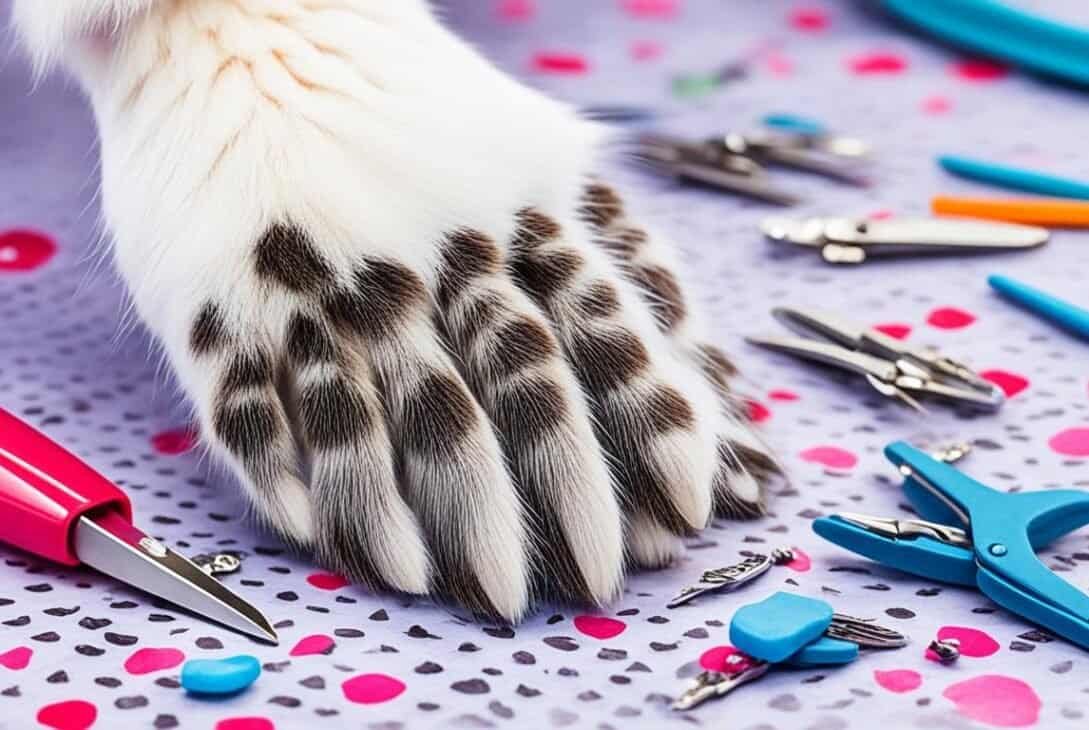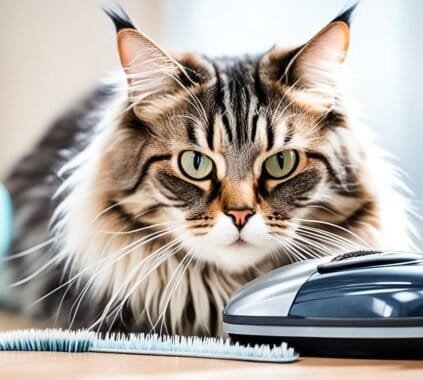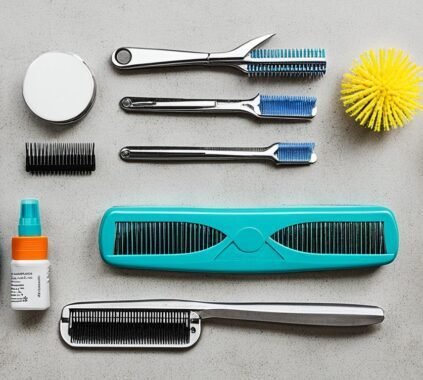Proper nail care is an essential part of cat grooming, and regular nail trimming is a crucial aspect of maintaining your furry friend’s paw health. Cats have retractable claws that continue to grow throughout their lives. If left untrimmed, their nails can become too long, curving inward and causing discomfort or the risk of infection. In this comprehensive guide, we will provide you with valuable information on cat nail trimming, safe methods, and DIY tips to help you ensure the well-being of your feline companion.
Key Takeaways:
- Cat nail trimming is important for maintaining paw health and preventing discomfort or infection.
- Regular trimming every two months is recommended.
- Use nail clippers designed for cats and trim without cutting into the quick.
- Consider providing a scratching post or using soft paws or nail caps as alternatives to regular trims.
- Seek professional help if needed or if you face challenges in trimming your cat’s nails.
How to Cut Your Cat’s Nails: Step-by-Step Guide
Trimming your cat’s nails is an essential part of their grooming routine. It helps keep their claws at a comfortable length, prevents scratching damage, and promotes paw health. Whether you plan to tackle the task yourself or opt for professional cat nail trimming, here’s a step-by-step guide to help you through the process.
Creating a Calm Environment
Before you begin, it’s important to create a calm and comfortable environment for your cat. Find a quiet room where you can both relax, and gather all the necessary tools, including sharp nail clippers designed for cats.
Familiarizing Your Cat with Nail Trimmers
Gently introduce your cat to the nail trimmers and let them sniff and investigate. This will help them become accustomed to the tool’s presence and reduce anxiety during the trimming process.
Holding and Massaging the Paws
Gently hold your cat’s paw while providing a soothing massage. This helps them get used to the sensation of having their paws touched and prepares them for nail trimming.
Squeezing the Tips of the Paws
When your cat feels relaxed, gently squeeze the tips of their paws to extend the claws. It’s important to handle this step with care and avoid exerting too much pressure to prevent any discomfort for your cat.
Using Proper Nail Clipping Technique
Once the claws are extended, identify the point where the quick starts (the part of the nail with live blood vessels) and avoid cutting into it. Trim only the tip of the nail to avoid any accidental injuries. If you’re unsure about the correct length to trim, consult a professional cat nail trimmer for guidance.
Trimming Nails Gradually
To reduce stress for your cat, trim one or two nails during each session. This gradual approach allows them to become more comfortable with the process over time.
Rewarding and Encouraging Your Cat
After each successful nail trim, reward your cat with treats and affection. Positive reinforcement helps create a positive association with the nail trims and encourages good behavior.
If you’re not confident in trimming your cat’s nails yourself or find it challenging, professional cat nail trimming services are available. They have the expertise and experience to handle the process safely and efficiently.
How Often to Trim Your Cat’s Nails?
The frequency of cat nail trimming depends on the individual cat and their nail growth. Claws should be trimmed every two to three months or when they have grown considerably long and pose a risk of injury or infection.
Regular scratching posts can help cats naturally maintain their claws and shed dead skin cells. Consider providing a variety of scratching surfaces, such as vertical posts, horizontal scratchers, or cardboard scratchers, to accommodate your cat’s preferences.
If your cat is resistant to scratching posts or you notice their claws are still becoming excessively long, you may need to trim their nails more frequently.
Another option to consider is using soft paws or nail caps. These are small covers that can be placed over your cat’s claws to prevent scratching damage. Soft paws need to be replaced every four to six weeks, so keep that in mind when deciding to use them.
It’s also important to monitor the sharpness of your cat’s claws. If you notice their claws are becoming extremely sharp, it may be necessary to file them down. Use a cat nail file or a human emery board designed for gentle filing.
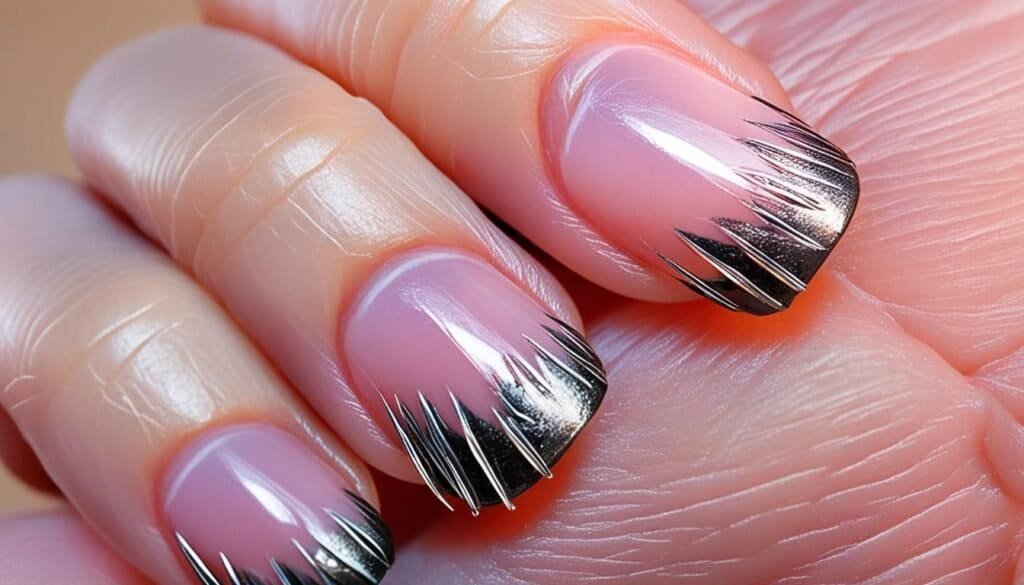
While regular nail trimming is essential, it’s equally important to approach the process with care and patience. Make sure to use nail clippers specifically designed for cats and avoid cutting too close to the quick, which can cause bleeding and pain.
If you’re unsure or uncomfortable with trimming your cat’s nails on your own, seeking professional help from a veterinarian or groomer is recommended. They have the experience and expertise to trim your cat’s nails safely and efficiently.
By maintaining the recommended trimming schedule, monitoring claw sharpness, and providing appropriate scratching surfaces, you’ll help ensure the health and well-being of your cat’s paws.
Troubleshooting Common Issues in Cat Nail Trimming
Bleeding, resistance, fear, and anxiety are common issues that pet owners may face during cat nail trimming.
If the cat’s nail starts bleeding, apply styptic powder or cornstarch to stop the bleeding.
If the cat is resistant or shows signs of fear or anxiety, take a step back and reassess the approach.
Gradual desensitization, positive reinforcement, and patience can help overcome these issues.
Advanced tips, such as regular paw handling practice, using a quality nail grinder, creating a calming environment, enlisting a helper, and monitoring claw sharpness, can further enhance the cat nail trimming experience.
Knowing when to seek professional help is also important for dealing with specific situations or challenges.
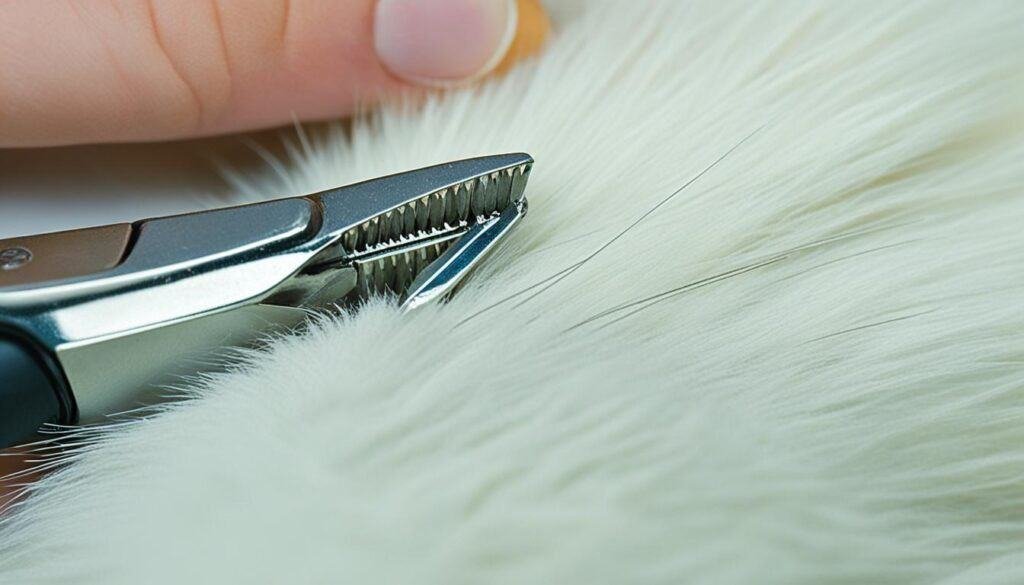
Dealing with Bleeding
- Apply gentle pressure with a clean cloth or cotton pad to the bleeding area.
- If the bleeding doesn’t stop within a few minutes, apply styptic powder or cornstarch to the nail tip, using gentle pressure.
- Keep an eye on the cat’s behavior and consult a veterinarian if there are any concerns.
Managing Resistance, Fear, and Anxiety
- Take a gradual approach, allowing the cat to get used to the presence of the nail clippers without immediately attempting to trim their nails.
- Practice positive reinforcement by rewarding the cat with treats and praise during and after successful nail trimming sessions.
- Consider using calming techniques such as pheromone sprays or creating a quiet and relaxing environment.
Enhancing the Cat Nail Trimming Experience
- Regularly handle your cat’s paws and touch their nails to help them become comfortable with the process.
- Invest in a quality nail grinder for a smoother and more controlled trimming experience.
- Create a calming environment by choosing a quiet and well-lit area for the nail trimming session.
- Enlist a helper, if needed, to assist in keeping the cat calm and still during the process.
- Monitor the sharpness of your cat’s claws and file them if necessary to prevent scratching damage.
By addressing these common issues and implementing the tips mentioned above, cat owners can ensure a smoother and more successful cat nail trimming experience.
Conclusion
Trimming your cat’s nails is a vital aspect of cat grooming and responsible pet ownership. Not only does it help prevent scratching damage and potential injuries to both humans and other pets, but it also reduces the risk of infections. By following proper techniques and maintaining a calm and positive environment, cat nail trimming can be a stress-free experience for both you and your furry friend.
Regular nail trimming, along with providing appropriate scratching posts and considering alternatives like soft paws, greatly contributes to the overall well-being of your cat’s claws. This essential grooming practice promotes healthy cat-human interactions and ensures the happiness of your feline companion.
For those who feel less confident in DIY cat nail trimming, seeking professional help from a veterinarian or a professional cat groomer is a recommended option. They possess the expertise and skills to trim your cat’s nails safely and efficiently, providing peace of mind and optimal cat nail care.
So, take the time to learn the right techniques, create a calm atmosphere, and prioritize the health and happiness of your pet by practicing cat nail trimming. With the right approach and knowledge, you can master this essential grooming task and ensure that your beloved cat’s claws are always in tip-top shape.
FAQ
What is the importance of trimming a cat’s nails?
How often should I trim my cat’s nails?
What are the best practices for trimming a cat’s nails?
Can I trim my cat’s nails myself?
What should I do if my cat’s nails start bleeding during trimming?
How can I handle my resistant or anxious cat during nail trimming?
What alternatives are available for cat nail trimming?
When should I seek professional help for cat nail trimming?
Last modified: February 25, 2024

